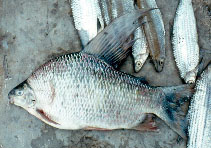| Family: |
Distichodontidae (Distichodus) |
| Max. size: |
19.5 cm SL (male/unsexed) |
| Environment: |
pelagic; freshwater, |
| Distribution: |
Africa: Lower Guinea endemic, only occuring in the Sanaga River basin, Cameroon (Ref. 7094, 51193, 81638). |
| Diagnosis: |
Dorsal spines (total): 0-0; Dorsal soft rays (total): 21-27; Anal spines: 0-0; Anal soft rays: 13-18. Diagnosis: 46-49 pored lateral line scales, followed by several smaller, unpored scales on caudal fin base; total dorsal rays 21-27; dorsal fin becoming increasingly elongate ontogenetically, tip of dorsal fin reaching beyond base of caudal fin in larger individuals (Ref. 81638).
Description: body deep, body depth 0.46-0.50 SL, becoming proportionally deeper in larger individuals, distinctly laterally compressed; mouth subterminal with 2 rows of bicuspid teeth in each jaw; maxilla edentulous; premaxilla with 9-13, dentary with 9-12 teeth in outer row, with higher numbers in both jaws typical of larger specimens; caudal fin lobes pointed, scales overlying rays; scales limited to basal portion of middle rays of each lobe in smaller individuals and extending further distally in larger specimens and reaching close to distal portions of dorsal and ventral most rays in largest individuals; body scales ctenoid and moderate-sized; 8 scales between anal fin origin and lateral line; D: IV-V,17-22 with first ray sometimes very short; A: II-IV,11-14 (Ref. 81638).
Coloration: tan to greyish brown, darker dorsally in preserved specimens; head with dark pigmentation extending across snout and upper portions, but otherwise without distinct pigmentation; body with series of thin, vertically elongate bars variably present from slightly posterior of opercle to above posterior limit of anal fin base; posterior-most bars sometimes vertically divided, with ventral components extending to short distance dorsal of anal fin base; bars somewhat wider in larger individuals, particularly along region above lateral line and consequently giving appearance of interrupted longitudinal band; vertically elongate spot on posterior portion of caudal peduncle; fins nearly hyaline in smaller specimens, but dusky, albeit without distinct pigmentation pattern, in larger individuals; unscaled distal portion of caudal fin lighter (Ref. 81638). |
| Biology: |
Maximum TL was recorded at 21.5 cm (Ref. 7094). |
| IUCN Red List Status: |
Least Concern (LC); Date assessed: 16 February 2009 Ref. (130435)
|
| Threat to humans: |
harmless |
| Country info: |
|
Source and more info: www.fishbase.org. For personal, classroom, and other internal use only. Not for publication.

